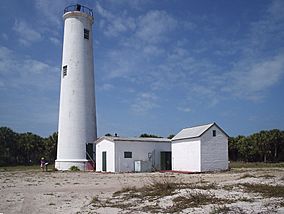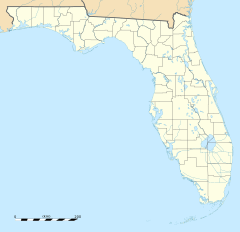Egmont Key State Park and National Wildlife Refuge facts for kids
Quick facts for kids Egmont Key State Park & National Wildlife Refuge |
|
|---|---|
|
IUCN Category IV (Habitat/Species Management Area)
|
|
 |
|
| Location | Hillsborough County, Florida, United States |
| Nearest city | St. Petersburg, Florida |
| Area | 328 acres (1.33 km2) |
| Established | 1974 |
| Governing body | Florida Department of Environmental Protection |
| Website | Egmont Key State Park |
|
Egmont Key
|
|
| Area | 450 acres (182 ha) |
| Built | 1840 |
| NRHP reference No. | 78000946 |
| Added to NRHP | December 11, 1978 |
Egmont Key State Park is a special park located on Egmont Key, an island at the mouth of Tampa Bay in Florida, United States. You can only get there by boat or ferry, as it's southwest of Fort De Soto Park.
The park is home to the Egmont Key Lighthouse and the old ruins of Fort Dade. This fort was built during the Spanish–American War. Egmont Key is part of Hillsborough County, stretching along the Tampa Port Shipping Channel.
The southern part of the island is also the Egmont Key National Wildlife Refuge, which started in 1974. The whole island, about 328 acres, is part of this refuge. It's one of three wildlife refuges in Tampa Bay, helping to protect nature. Egmont Key was added to the U.S. National Register of Historic Places on December 11, 1978, because of its important history.
Contents
Animals You Might See
Egmont Key is a great place to spot different animals. You might see gopher tortoises slowly moving around. Look up for colorful hummingbirds flying by. Many kinds of seabirds also live here, making it a lively place for nature lovers.
Fun Things to Do
There are lots of fun activities at Egmont Key State Park! You can relax and enjoy the sun by sunbathing on the sandy beaches. Take a dip in the water for swimming or try snorkeling to see underwater life. If you like collecting, you can go shelling to find unique shells.
It's also a great spot for boating and picnicking with friends and family. You can explore the old fort ruins, which is like stepping back in time. Don't forget to spend time wildlife viewing, as there are many animals to observe. The park has nature trails for walking and picnic tables for your meals. Remember, there's no food, water, or restrooms on the island, so plan ahead! Also, no alcoholic drinks or pets are allowed.
Park Hours
The park is open every day of the year from 8:00 AM until sundown. This gives you plenty of time to explore and enjoy the island.
Island's Past
Egmont Key has a long and interesting history. Spanish explorers first mapped the island in 1757. In 1761, the English named it Egmont Key after the Earl of Egmont. Over the years, control of Florida, including the island, went back and forth between Spain and England. Finally, in 1827, it became part of the United States.
The Lighthouse and the Great Gale
Because it was hard for ships to navigate into Tampa Bay, the first lighthouse was built in 1847. But a huge storm called the Great Gale of 1848 hit the island hard. It almost destroyed the lighthouse! The lighthouse keeper was very brave and rode out the storm in a small rowboat tied to a palm tree. After the storm, he rowed to Fort Brooke and decided to quit his job. A new lighthouse was built in 1858.
From Fort to Park
During the Spanish–American War, Fort Dade was built on Egmont Key to protect the area. The island remained a military base for many years. In 1974, the U.S. Fish and Wildlife Service started managing the island. Then, in 1989, it was given to the State of Florida and became a state park. In 2009, there was a plan to close the park due to money problems, but thankfully, it stayed open.
Harbor Pilot Station
For over 70 years, Egmont Key has been an important place for ships entering and leaving the port of Tampa. It's where harbor pilots meet ships to guide them safely through the bay's channels.
Gallery
-
Beach on the east side of the island with the Sunshine Skyway Bridge in the background.
-
View looking east toward Fort De Soto Park.
-
A Gopher tortoise resting by a nature trail.













